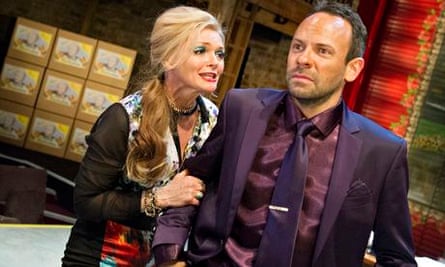There isn’t a surviving copy of the 1590 first edition of The Life of Long Meg of Westminster because, judging by a reprint, the cheap chapbooks must have been read, like comics, until they disintegrated. Which seems right, given that the publication is a graphic novel without pictures. Across 18 short chapters, there’s cracking dialogue and a lot of action – sword and shield, wrestling, boxing, quarterstaff.
Long Meg, who might faintly be historical, though probably not, is a Lancashire lass come down to London in the reign of Henry VIII to make good in a tavern job. She’s two metres tall and unworried by violence; she starts by beating up the carrier who tries to overcharge for her trip south, and thumps her way through international lotharios, career criminals and predatory Catholic clerics (she’s a Protestant superheroine).
She also takes the place of a military conscript – out of fellowship, not love – in the French wars. She usually fights in her working skirts, but on occasion suits up, and is the English-language origin of that familiar trope – OMG, it’s a WOMAN: “But at last Meg overthrew him … and with that, pulling off her burgonet [helmet], she let her hair fall about her ears, whereby the Frenchmen perceived she was a woman.”
I say English-language origin, because the warrior heroines in Ariosto’s fantasy/sci-fi Italian epic, Orlando Furioso, had had their L’Oréal moments for about 60 years by the time of Meg’s publication. An English translation of Orlando only came out the year after Meg.
Of course, there were the bestselling ballad versions, and a dramatisation: the Admiral’s Men staged it more than a dozen times at the Rose in 1595-96, a solid earner with the company’s lanky star Edward Alleyn in drag and wig as Meg. It’s a lost play – we forget how much pop tosh came and went in the Elizabethan-Jacobean-Stuart rep. Yet themes nicked from Meg, and others from the even bigger-selling ballad of Mary Ambree, about a fictional female officer avenging the death of her sergeant-major lover in the Spanish-Flemish wars, recur in plays we do have from the next century.
But not in Shakespeare. His get-out is that his girl-boy heroines are specified as too young to fight – page-age Viola in Twelfth Night is, not unreasonably, terrified of being set up to duel with what she presumes is an adult male trained in fencing. But genre playwrights of the era, starting with Thomases Heywood, Middleton and Dekker, regularly pinched Meg’s most famous scene – the fight with a misogynist swaggerer.
Heywood borrowed it first for his Fair Maid of the West, written around 1600, a Technicolor high-seas adventure in which tavern manager Bess Bridges, wrongly believing her posh sweetheart killed in action in the 1597 English raid on the Azores, buys and fits out a ship, sets sail to retrieve his body, and when that can’t be achieved turns vengeful privateer against the Spanish, amassing a plundered fortune in her black pirate vessel under its black flag.
Foremost among her crew is a cowardly bully whom reformed in a scene lifted straight from Meg, by defying him alone, dressed and armed as a man. She doesn’t even have to thwack him to break him – Heywood’s innovation is that she does it with threats, brain over brawn, and no immediate hat-doffing reveal. (In the 1986 RSC production, the young Imelda Staunton as Bess out-swashed even Sean Bean as her lover.)
It’s likely the play originally ended with her happy reunion with her chap, only we can’t be sure because Heywood rewrote it 30 years later as the first act of Fair Maid II, a court-pleasing sequel dulled with lust and double-crosses, in which a frock-wearing Bess is given a miserable female time, including squeaking “help” when threatened with rape after shipwreck.
In 1611, Middleton and Dekker went straight for a copy of the weaponed-up Meg defeating a man who despises women in The Roaring Girl, which has been revived as part of the RSC’s heroines season.
The git thinks he’s keeping a sexual assignation with the famous Moll Cutpurse, assuming that she’s a whore because she’s a cross-dresser, not to mention a fence who retrieves stolen goods in an uninsured era. The writing team were working round the temporary notoriety of the real Mary Frith, a petty thief and drunken Bankside brawler, who did her own live standup as a novelty at the Fortune theatre soon after The Roaring Girl showed there.
Frith was less glamorous than her media version, yet definitely and illegally went beyond fashionable androgynous styling into wearing proper male, buttoned doublet and wide Dutch slop breeches, clay pipe of tobacco in her hand. She wasn’t a gracious silence, she wasn’t suppressible by social convention, and her court-ordered public repentance at Paul’s Cross was only tearful because she was maudlin drunk at the time.
Middleton and Dekker constructed The Roaring Girl as a smart City romcom of thwarted young lovers and adulterous middle-aged marrieds. The real fun in it was no-romance Moll, who has no interest in marriage except to play conniving Cupid to the lovers: she’s the core of the play and its topical selling point, as champion of the honour of poor women, and also a cool, professional crime boss, drawling the hardman thieves’ lingo and with nothing to fear from male threats as she fights pre-emptively dirty – sweeping out the feet of the belligerent from under them for starters.

It’s a terrific role, since Moll has all the best jokes, blithely filthy, plus heartfelt speeches on the lousy lot of most working women, and wants nothing but to remain herself, in profit, and at a sane distance from the bourgeoisie. The last time the RSC staged it, in 1983, Helen Mirren played Moll as an attitudinous punk in slops with a touch of the safety-pinned bin bag about them.
Aphra Behn, the female playwright, and traveller to the Americas, tapped the Meg-Moll-Mary tradition for her last play, The Widow Ranter, written just before she died in 1689. It’s a neglected play, even for Behn: I suspect that is because it is the earliest recognisable western, every trope already in place out on the wild frontier of Virginia, a place of chancers, outlaws, bushwhackers, lynch mobs and lax lawmen in the corrupt settlement of Jamestown, and savage yet noble natives. Did I mention the “buffilo” (buffalo)?
Behn gave the story two male leads: the anti-hero Nathaniel Bacon, based on the leader of a real colonial revolt in 1676, doomed by his love for a Native American (he kills her by accident and she dies in his arms: told you this was a western); and Daring, who is the missing link between a Restoration rake and a tumbleweed gunslinger. But it’s the smoking, hard-drinking, harder-spending Widow who sashays off with the play, as Moll Cutpurse had done before her. She was poor, is now richer than all the men put together while still being uproariously free – her punchbowl in procession is preceded by her own Scots piper, she traipses off to eat buffilo with native acquaintance.
She also, despite a rock-hard head, fancies Daring, whom she pursues into the big set-piece showdown, dressed as a man, “fighting like a Fury by his side, he putting her back in vain; they fight out”. Daring knows she’s faster on the (sword) draw than he is, “ten to one she beats me”, but decides to marry her, still in breeches, “for I never lik’d thee half so well in Petticoats”.
And then the 18th century, and morality, and sensibility, overtook heroines on the respectable stage (low melodrama, mother to movies and comics and telly, is quite another story), and no Meg beswindged or cudgelled or lammed her way through a serious scene again.
The heroines season, comprising The Roaring Girl, Arden of Faversham and The White Devil, continues until 29 November.
The Roaring Girl review – ‘A spirited start to the RSC’s heroines season’

Comments (…)
Sign in or create your Guardian account to join the discussion